ZEN MESTEREK ZEN MASTERS
« Zen főoldal
« vissza a Terebess Online nyitólapjára

李蕭錕 Li Xiaokun (1949-)
Quenten Lee / Lee Hsiao-kun
Quenten Lee
— Born in 1949.
— Gained a master degree from Graduate Institute of Arts in Chinese Culture University.
— Worked as: Associate Professor of Department of Fine Arts and Graduate Institute of Design,
Huafan University and Review Committee Member of National Art Exhibition, Ministry of
Education Literature and Art Creation Awards, and Taipei County Art Exhibition.
— Associate Professor of Department of Fine Arts, Taipei National University
of the Arts. Retired.
— Focus on researching theory and practice of calligraphy and painting. Has been invited to
exhibit his works scores of times in Taiwan’s and other countries’ major exhibitions.
Zen Paintings by Li Xiaokun (DOC)
Zen Illustrations by Li Xiaokun (DOC)
《十牛圖》 "Ten Oxherding Pictures" (DOC)
https://www.facebook.com/profile.php?id=100004788219220&fref=nf
http://www.hancha.hk/2015/01/zen-painting-by-mr-quenten-lee.html
http://library.uwest.edu/booksub.asp?OCLCNo=191868654
http://www.books.com.tw/products/N000454163
http://buddhall102.pixnet.net/blog/category/3804566
![]()
https://www.youtube.com/watch?v=Qi1BkxGShUY
Content of the Heart
by Audrey Wang
Taiwan Review, 11/01/2012
http://taiwanreview.nat.gov.tw/ct.asp?xItem=197518&CtNode=1210
Quenten Lee utilizes his skills in different art forms to create works that reflect his insights into life.
Color and line are often considered the two key elements of painting, and artist Quenten Lee (李蕭錕) has been fortunate enough to master both. When Lee was in his early 30s, he made a name for himself by creating the color scheme for the interior of National Chiang Kai-shek Memorial Hall, a famous monument and popular tourist destination in Taipei. As for line, Lee, who is now 63 years old, has been a devotee of calligraphy for years and has written several books on the subject. “Once you master calligraphy, you master the lines [in painting],” he says.
Born in Dayuan Township in Taoyuan County, northern Taiwan, Lee loved to paint as a child. He attended the usual art classes in primary and secondary school but did not receive any specialized training until he entered the Fine Arts Department at Chinese Culture University (CCU) in Taipei. During his first two years there, Lee studied in a wide range of disciplines including design, oil painting, traditional Chinese ink painting and watercolors, and says he was always at the top of his class in each field.
Lee eventually had to choose between disciplines, however, as his department required students to begin majoring in one during their junior year at CCU. “Many teachers invited me to join their groups and I was torn,” he says. “So I decided to flip a coin to help me make the decision. Three times in a row, the coin told me that I should choose to major in traditional Chinese painting, so that’s what I did.”
Lee recalls that his decision surprised many of his classmates, as his predilection for the unconventional was widely known. “I permed my hair and let it grow down to my shoulders. I played the guitar and loved to sing Western songs,” he says with a smile. “They all assumed it was only natural for me to major in Western painting, but I did just the opposite. You can imagine the reaction when they heard the news.”
Besides the obvious mismatch with his personality, Lee was also aware that his skills in traditional Chinese painting were weaker than his Western painting skills. Despite such concerns, Lee went on to devote his last two years of college to studying Chinese painting and related art forms including calligraphy and seal, or chop, engraving. In his studies at CCU, he received training from some of Taiwan’s most prominent artists, including traditional Chinese painters Ou Hao-nien (歐豪年) and Chiang Chao-shen (江兆申, 1925–1996), calligraphers Chuang Yen (莊嚴, 1899–1980) and Tseng Shao-chieh (曾紹杰, 1911–1988), seal engraver Na Zhi-liang (那志良, 1902–1998) and art historian Lee Lin-tsan (李霖燦, 1913–1999).
It was also at this time that Lee fell in love with calligraphy, an art form that he has practiced ever since. Lee says that calligraphy is the fundamental basis for all of his creations. “Practicing calligraphy helped me develop the dexterity to use brush pens,” he explains, adding that by properly spacing the strokes when writing with a brush, he also learned to arrange the layout of a painting in a more aesthetic manner.
Looking back, Lee says he is glad the thrice-tossed coin pointed him toward traditional Chinese painting. “It gave me the opportunity to strengthen my weakest link,” he says.
Lee graduated from CCU in 1972, performed his compulsory military service and then went back to the university in 1974 to start his graduate studies in art theory. After receiving his master’s degree in 1976, Lee began teaching at CCU as a part-time lecturer in the fields of painting and art theory.
Lee’s career took a sharp turn in 1979, when he accepted a job as a color consultant for ICI Dulux Paint, a well-known international paint maker that was then headquartered in the United Kingdom. A major part of his job, Lee says, was promoting the use of colored paint as a fundamental part of architecture in Taiwan, Hong Kong and countries in Southeast Asia.
In those days, however, the concepts of choosing color palettes and creating color combinations had yet to develop fully in Taiwan, Lee points out. “I remember that we held at least two seminars every month to teach architects and those in related professions to mix and match colors,” he says. Promoting the Dulux brand was difficult at that time, he adds, as the company’s paint cost about three times as much as other brands on the market.
To distinguish Dulux paint from that made by competitors in Chinese-speaking markets, Lee relied on the keen sense of color he developed in college to rename nearly 400 Dulux paint products. He notes that the company originally used names like Red No. 1 and Blue No. 2, which made it almost impossible for consumers to visualize the color. “[Instead,] I came up with names like Thin Smoky Blue, Lake Water Green, Sunset Red, Jasmine White and Lemon Yellow. It’s always important to use creativity to generate that kind of added value for a product,” he says. Lee believes that his efforts not only helped boost the popularity of Dulux paint, but also prompted many other paint suppliers to rename products sold in Chinese-speaking markets in a similar way.
Lee was successful at Dulux and extremely busy in those days, as he continued to lecture at CCU. Finally, after seven years working for the paint brand, he quit in 1985 to spend more time creating art, although he continued teaching part-time. His newfound free time did not last long, however, as in 1986 he took another part-time job as a publisher for a magazine.
In 1993, Lee decided that his family should immigrate to Australia to give his children a chance at a better education. It was only after settling in that country that he finally gained the free time he had longed for. He also found that Australia’s scenery and relaxed atmosphere inspired him to take up oil painting again. He created more than 100 oil paintings over the following two years, largely in an abstract style. “I used pieces of iron to scrape paint [on the canvas] to create a kind of oil painting similar to the abstract expressionism [commonly] found in traditional Chinese ink painting,” Lee explains. “No paintbrush was used in those works.”
Buddhism by Brush Pen
Meanwhile, Lee continued practicing calligraphy and began putting it to use to transcribe Buddhist scriptures. Shortly after Lee moved his family to Australia, his father became ill and was hospitalized in Taiwan, leading the son to seek solace in books about the religion. From there, it was only natural for Lee to express his growing interest in Buddhism with the brush pen. “I spoke the Buddha’s name in my heart once for every stroke I wrote,” he says. “By doing that, I hoped to give my father a blessing that would speed his recovery.”
Unfortunately, Lee’s prayers went unanswered. His mother passed away in 1995, her death hastened by the strain of taking care of his father, who then passed away two months later. Lee returned home for his mother’s funeral and has remained in Taiwan ever since. Exploring Buddhism took on added urgency for Lee after the passing of his parents. “I began to have doubts about life. I felt great loss and found it hard to believe that the people I had been so close to were suddenly gone,” he recalls. “These feelings served as an important incentive for me to go deeper into studying Buddhism.”
That grief-stricken period marked a turning point in Lee’s career as an artist, as he let go of the practice of oil painting and devoted himself to conveying the wisdom of Buddhist texts in traditional Chinese ink paintings. In those works, he uses little monks to reveal insights gleaned from his studies. Near the edges of the paintings, he often uses the brush pen to write scriptures that are especially meaningful or offer a few words that describe the people or the meaning of the image. The work A Man Crossing a Bridge from this year, for example, depicts a monk walking across a bridge that connects two mountains, while the words “the bridge flows, not the water” are written on the side. Lee explains that the inspiration for the work came from his realization that only elements of nature such as water have permanence, while people and bridges will cease to exist someday.
Although Lee dwells on such serious themes, his paintings have the surprising effect of reminding viewers more of life’s contentment than sorrow. One such viewer is Lin Chien-chi (林倩綺), commissioner of New Taipei City’s Cultural Affairs Department. At the opening of Lee’s solo exhibition in New Taipei City in August this year, Lin said Lee’s works “show his elegant humor, down-to-earth creative style and humorous attitude toward life.”
Lin Ku-fang (林谷芳), chairman of the Graduate Institute of Art Studies at Fo Guang University in Yilan County, northern Taiwan, notes the depth of the artist’s pieces. “Lee’s paintings may appear raw and plain [at first glance], but are in fact so natural and full of life,” he says.
Lee says that he likes to challenge common assumptions and stereotypes such as considering calligraphy only an artistic form of handwriting, and that painting skills are irrelevant to letters or characters. “The concept of binary opposites causes narrow-mindedness in art creation and suffocates our ability to innovate,” he says. “Channels of communications can always be found between two art forms; we just seldom look for them.”
New Kind of Art
The marriage of two artistic disciplines can be found in Lee’s recent seal engravings. Whereas stone seals are typically inscribed with varying styles of Chinese characters, Lee carved the images of 100 women into 100 pieces of stone, with each representing a beauty of her own age, country and culture. “Who says that we can only carve characters or letters on a seal?” he asks, adding that he only decides the particular image he is going to create after he sees a piece of stone, as he refuses to alter its basic shape. The greatest joy of being an artist is the possibility of creating a kind of art that has never been seen before, Lee says, adding that he never lacks inspiration for that reason.
While Lee prefers an unfettered approach, Lin Ku-fang, for one, believes that the profound insights the artist has gained through studying Buddhism form the heart of his work. Lee’s proficiency in varied disciplines such as calligraphy and painting in color would be just technical skills and could even limit the artist’s vision if he did not rely on that wisdom in the creative process, the professor says.
Lee believes, however, that all knowledge was originally part of a whole before it was divided into separate disciplines, adding that he simply utilizes everything he has learned to unite the parts once again. “Every category of knowledge is interconnected and we have to look beyond the boundaries between them,” he says.
Lee does agree with Lin Ku-fang, however, that in the end, art has to come from within. “Train your heart rather than training your hands and eyes, because your heart is always in control,” he says. “Creation is a product of heart. When the awareness of the heart is elevated to a certain level, the content of the artwork will be abundant.”
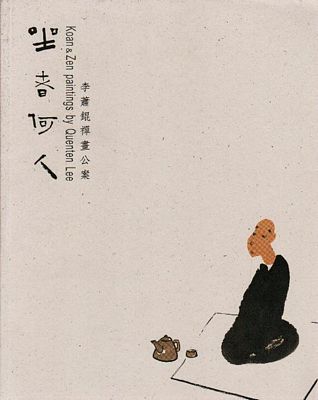
《坐者何人 ‧ 李蕭錕禪畫公案》
Zuo zhe he ren : Li Xiaokun chan hua gong an
English title on cover: Koan & Zen paintings by Quenten Lee
台北市 : 香海文化事業有限公司, 2007.; Taibei Shi : Xiang hai wen hua shi ye you xian gong si, 2007. 199 p.
ISBN : 9789867384676
Introduction: The Identity of Life
About Zen Painting Regarding Creation; training your hands is not
as good as your eyes; training your eyes is not as good as your mind.The rnind controls everything; the hands and eyes go with the
mind, so the image appears accurately from the bottom of the mind.
Therefore, what is called creation, naturally, should be the product of
the mind. When the quality of the mind is raised to a certain condition
or level, the products of creation will be very impressive.The frame of mind is related to a person's experience of living and
ol his consciousness of life; when time and place change, the frame of
mind might be transformed at the same time. The more courage you
have to face suffering, the rnore you have the chance to open the door
to wisdom. Escape is another choice, but it is the worst one, becauset
then you will never get the chance to enter the store house of the mind
and learn from your painful experiences, therefore, it is very difficult
to achieve this wisdorn.One who desires to achieve this, he has to learn bravely to release
the veil from his face, so that, his true feature will be revealed.When all the external factors are truly reflected onto the smooth
and quiet mirror of the mind without distortion, your thoughts may
judge them clearly, and you may do whetever you like.Meanwhile, the potential of the deep sea of wisdom may grow, so
that, when the moment of affinity happens, wonderful and ingenious
delights are spread all over your life and work, which, as a result, also
become enjoyable and definitely also become a real creation.Painting is one form of creation; Why not also eating and
sleeping?I am a painter in occupation on my identity card, but what is the
identity of my LIFE?Quenten Lee
TEREBESS GÁBOR FORDÍTÁSAI
李蕭錕 LI HSZIAO-KUN ILLUSZTRÁCIÓI (2007)
Ta-csien Huj-neng, a 6. pátriárka, 638-713A szél lobogtatta a templomi zászlót. Két szerzetes arról vitatkozott, vajon a zászló mozog-e vagy a szél. Csűrték-csavarták a szót, de egyikük sem tudta meggyőzni a másikat.
Egyszer csak megszólalt mellettük a hatodik pátriárka:
– Nem a szél és nem a zászló az, ami mozog. Hanem a tiszteletre méltó elmétek.
A szerzetesek riadtan elhallgattak.
Jen-kuan Csi-an, 750?-842Jen-kuan szólt egy szerzetesnek, hogy hozza oda az orrszarvúcsont legyezőjét.
– Eltört – mondta a szerzetes.
– Akkor hozd ide az orrszarvút! – mondta Jen-kuan.
A szerzetes nem válaszolt.
Nan-csüan Pu-jüan (Vang mester), 748-834/5Lu Keng [Lu Hszüan kormányzó, 764-834] , Hszüancseng kormányzója tanácsot kért Nan-csüantól:
Egy kő lakik a házamban, és mást se tesz, csak ül vagy fekszik. Lehet Buddhát faragni belőle?
– Lehet.
– Tényleg nem lehetetlen?
– Most már az – mondta a mester. – Lehetetlen.
Csao-csou Cung-sen, 778-897– Miért jött ide nyugatról Bódhidharma? – kérdezte egy szerzetes.
– Ciprusfa az udvaron – felelte Csao-csou.
Csao-csou Cung-sen, 778-897– Még egy ilyen nagy bölcs se szabadulhat a portól? – kérdezte a söprögető Csao-csout egy látogató.
– A por kívülről jön – felelte Csao-csou.
Csao-csou Cung-sen, 778-897Máskor egy szerzetes szólította meg:
– Hogy találsz egy porszemet is ilyen ragyogó tiszta kolostorban?
– Nézd, itt van még egy – nyugtatta meg Csao-csou
Csao-csou Cung-sen, 778-897– Most érkeztem a kolostorba – fordult egy szerzetes Csao-csouhoz. – Mondd, mi a tanításod lényege!
– Megreggeliztél már?
– Igen.
– Akkor menj, és mosd el az evőcsészédet!
A szerzetes egyszerre megvilágosult.
Csao-csou Cung-sen, 778-897Egyik reggel Csao-csou az új szerzeteseket fogadta:
– Jártál már itt? – kérdezte az egyiket.
– Igen.
– Gyere, igyál egy csésze teát!
Aztán egy másikhoz fordult:
– Jártál már itt?
– Még nem.
– Gyere, igyál egy csésze teát!
A szerzetes-felügyelő félrehívta a mestert:
– Az egyik már járt itt, erre te megkínálod teával; a másik még nem járt itt, erre te ugyancsak teával kínálod. Jelent ez valamit?
– Felügyelő! – szólt Csao-csou.
– Tessék.
– Gyere, igyál egy csésze teát!
Csao-csou Cung-sen, 778-897Egyszer egy szerzetes megkérdezte Csao-csout:
– Van-e a kutyának buddha-természete?
– Nincs – felelte Csao-csou.
– Minden lénynek van buddha-természete, a buddháktól a hangyákig – folytatta a kérdező. – Miért épp a kutyának nincs?
– Mert válogatós.
Paj-csang Huaj-haj, 720-814Alighogy sétára indultak, mester és tanítványa, vadludak szálltak el a fejük felett.
– Mik ezek? – kérdezte Ma-cu.
– Vadlibák – nézett föl Paj-csang.
– Merre szállnak?
– Már elhúztak!
Ma-cu megragadta és úgy megcsavarta Paj-csang orrát, hogy tanítványa felüvöltött kínjában.
– Hogy húztak volna el?! – harsogott Ma-cu.
Paj-csang feleszmélt.
Paj-csang Huaj-haj, 720-814Egy nap Paj-csang megkérte Kuj-sant, nézze meg a tüzet.
Kuj-san fogta a piszkavasat, beletúrt a hamuba, majd közölte, hogy a tűz kialudt.
Paj-csang erre maga ment a tűzhelyhez, és hosszas keresgélés után kipiszkált a hamu alól egy lappangó kis parazsat. – Hát ez nem tűz? – kérdezte.
Kuj-san Ling-ju, 771-853Kuj-san már nyugovóra tért, mikor Jang-san [Jang-san Huj-csi, 807-883] beszélgetni jött hozzá. Mihelyt a mester meglátta, a falnak fordult.
– Hogy tehetsz ilyet? – kérdezte Jang-san.
– Álmodtam valamit – mondta Kuj-san és felült. – Fejtsd meg!
Erre Jang-san hozott egy mosdótál vizet.
Kisvártatva Hsziang-jen jött beszélgetni a mesterrel.
– Álmodtam valamit – mondta neki is Kuj-san. – Jang-san már megfejtette. Most te következel.
Erre Hsziang-jen hozott egy csésze teát.
Hsziang-jen Cse-hszien, ?-898Hsziang-jen remetekunyhója előtt az ösvényt takarította. Félredobott egy követ, mely véletlenül száron vágott egy bambusznádat. Az éles csattanásra egyszeriben megvilágosult.
Jün-jen Tan-seng, 780?-841– Ki hallja meg az élettelen tárgyak tanítását? – kérdezte Tung-san.
– Az élettelen tárgyak – mondta Jün-jen.
– És tisztelendőséged hallja?
– Én nem, mert akkor te se hallanád a tanításomat!
– Miért ne hallanám?
Jün jen felemelte a légycsapóját:
– Hallod?
– Nem.
– Ha engem se hallasz, hogy hallanád az élettelen tárgyak tanítását?
Tung-san írt egy tanverset és bemutatta a mesternek:„Ó, milyen furcsa, milyen csodás!
Az igaz hallás nem fül-hallás,
A tárgyak szavát fel nem foghatod,
Csak ha a szemeddel hallgatod.”Tung-san még némi kétséggel terhelten távozott Jün-jentől. Útközben, ahogy átkelt egy patakon, meglátta saját tükörképét a vízben. Hirtelen megvilágosult, és boldogan énekelte:
„Egyedül járok, és mindenütt szembe jő,
Ő az, aki vagyok, én mégse vagyok Ő.”
Jün-men Ven-jen, 864-949– Mi a buddhizmus alapeszméje?
– Ha eljő a tavasz, kizöldül a fű magától.
Jün-men Ven-jen, 864-949Jün-men megkérdezte egy szerzetestől, honnan jött.
– Csianghszi tartományból.
– Motyognak még álmukban az öreg mesterek?
A szerzetes nem válaszolt.
雲門文偃 Yunmen Wenyan (864–949)– Elvénhedt a fa, hullatja levelét? – kérdezte egy szerzetes Jün-mentől.
– Őszi szélben látszik a törzse – mondta a mester.
Pa-ling Hao-csien, 10. sz.– Mi a különbség a csan pátriárkák és Buddha tanítása között? – kérdezte egy szerzetes.
– A tyúkok, ha fáznak, felülnek a fára; a kacsák, ha fáznak, lebuknak a vízbe – felelte Pa-ling.
Fa-jen Ven-ji, 855-958Egyik nap pirkadatkor Fa-jen a bambuszredőnyre mutatott. Mindjárt két szerzetes sietett oda, hogy felgöngyölje.
– Az egyik nyert, a másik vesztett – mondta Fa-jen.
Ling-jün Cse-csin (?-?) megvilágosodás-verse:„Mester kardját kerestem harminc évig,
Hullt a levél, fakadt a rügy hányszor,
Ám barackfa virágát néztem egyszer,
És többé nem gyötör a kétség.”
Kuj-san Ling-ju, 771-853; Paj-csang Huaj-haj, 720-814Kuj-san kolostori szakácsként szolgált Paj-csang mester alatt, amikor az apátot keresett a Ta-kuj-hegyi kolostor élére. Összehívta a szerzeteseit, és közölte velük, hogy az lesz a főapát, aki helyesen felel a kérdésére.
Egy vízzel teli korsót állított a földre, majd megkérdezte:
- Ha ezt nem nevezhetitek vizeskorsónak, mit tudtok rá mondani?
- Hát fatuskónak mégse mondhatjuk! – próbálkozott a rangidős szerzetes-felügyelő.
Paj-csang ekkor a szakácsot szólította.
Kuj-san odament, felrúgta a korsót, majd sarkon fordult.
- Vesztettél! – nevette ki Paj-csang a felügyelőt.
Így lett Kuj-san az új kolostor főapátja.

Dongshan Shouchu (910-990)
Egy köteg len(kóró) lóg a mérlegen– Mi a Buddha? – kérdezte egy szerzetes.
– Három mérő len(zsávoly) – mondta Tung-san Sou-csu.

丹霞天然 Danxia Tianran (739-824) eltüzeli a BuddhátVándoréveiben Tan-hszia egy dermesztően hideg templomban éjszakázott. Más tüzelőt nem találván, az oltár egyik fából faragott Buddha szobrával gyújtott be, hogy felmelegedjen.
A templom papja mélységesen felháborodott.
Tan-hszia piszkálgatni kezdte a parazsat:
– Bárhogy keresem, nem találom Buddha csont ereklyéit- mondta.
– Hogy találhatnál csont ereklyéket egy fa-Buddhában?
– Ha nincsenek, akkor raknék még egy szobrot a tűzre!
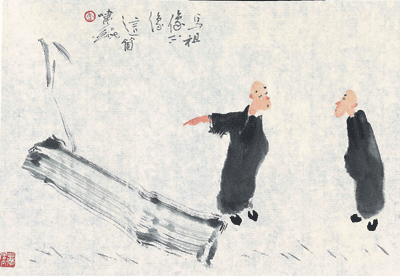
石頭希遷 Shitou Xiqian (700–790)– Honnan jöttél? – kérdezte Si-tou egy most érkezett szerzetestől.
– Csianghsziből.
– Láttad a nagy Ma-cu mestert?
– Láttam.
Si-tou egy farönkre mutatott:
– Milyen Ma-cu ehhez képest?
A szerzetes nem felelt. Visszatért Ma-cu mesterhez és elmesélte neki, mi történt.
– Láttad, mekkora rönk volt? – kérdezte a mester.
– Hatalmas – mondta a szerzetes.
– Nahát, ilyen bivalyerős vagy?
– Hogyhogy?
– Nem kis dolog Nanjüeből idáig cipelni egy akkora rönköt.

臨濟義玄 Linji Yixuan (?–866)Egy nap, mikor Lin-csi fenyőt ültetett, arra járt Huang-po:
– Mi értelme még több fát ültetni ezen a hegyvidéken? – kérdezte.
– Először is szépíteni a kolostor környékét, másodszor tájékoztatni a jövő nemzedéket – felelte Lin-csi, és kapájával háromszor megdöngette a földet.
– Jól van – szólt Huang-po. – Már kaptál tőlem harminc botütést.
Lin-csi újfent megdöngette háromszor a földet és sóhajtott egy nagyot.
– Rajtad keresztül aztán virul majd a tanításunk! – jegyezte meg Huang-po.

雲門文偃 Yunmen Wenyan (864–949)Jün-men azt kérdezte egyszer:
– Végtelen tág a világ, harangcsendülésre hétrészes csuhát vajon minek öltesz?
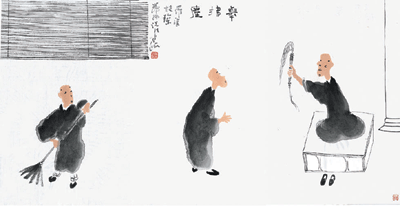
羅漢 (地藏) 桂琛 Luohan (Dizang) Guichen (867-928)Lo-han látott egy közeledő szerzetest, és felemelte a légycsapóját. A szerzetes leborult előtte.
– Minek hajbókolsz? – kérdezte Lo-han.
– Hálából.
Lo-han rácsapott:
– Ha látod, hogy emelem a légycsapót, rögtön leborulsz, de miért nem hálálkodsz akkor, ha a szobát vagy a kertet söpröm?

芙蓉道楷 Furong Daokai (1043-1118) & 投子義青 Touzi Yiqing (1032-1083)Kaj [Fu-zsung Tao-kaj, 1043-1118] szakácsként szolgált Tou-ce kolostorában.
– Nem könnyű szakácsnak lenni – szólította meg egy nap Tou-ce.
– Milyen jó vagy hozzám!
– Az a dolgod, hogy nyákot és rizst főzzél?
– Hát az egyik segítő megmossa a rizst és megrakja a tüzet, a másik pedig megfőzi a nyákot és a rizst.
– És te mit csinálsz?
– Jóságod folytán semmi dolgom sincs, csak lebzselek egész nap.
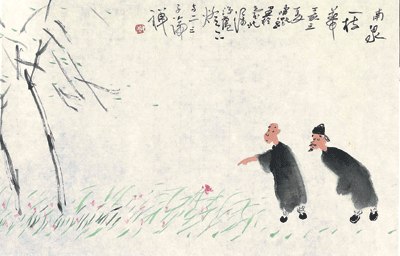
南泉普願 Nanquan Puyuan (王老師 Wang laoshi) (748-835)– Csao, a Törvény tanítója szerint az Ég, a Föld és mi magunk egyazon gyökérből eredünk. Nemde különös? – tűnődött Lu Keng kormányzó.
Nan-csüan a bazsarózsákra mutatott a kertben és azt mondta neki:
– Mostanában az emberek mintha csak álmukban látnák ezeket a rózsákat.

禾山無殷 Heshan Wuyin (884–960)Ho-san addig üti a dobot
Ho-san felemelte a szavát: „A tanulás művelését hallgatásnak hívják. A tanulás abbahagyását közeledésnek hívják. De a valódi túllépés az, ha túllépünk mindkettőn.”
Egy szerzetes előrelépett, és megkérdezte: „Mi az, amin valóban túllépünk?”
Ho-san azt mondta: „Tudom, hogyan kell dobolni.”
A szerzetes tovább kérdezett: „Mi a végső igazság?”
Ho-san azt mondta: „Tudom, hogyan kell dobolni.”
A szerzetes tovább kérdezett: „Az elme a Buddha” – de én nem erről kérdezlek, hanem arról, hogy mi a „sem-elme, sem-Buddha?”
Ho-san azt mondta: „Tudom, hogyan kell dobolni.”
A szerzetes tovább kérdezett: „Mi lesz, ha megérkezik a megvilágosult?”
Ho-san azt mondta: „Tudom, hogyan kell dobolni.”
松尾芭蕉 Matsuo Bashō (1644-1694)よく見れば薺花咲く垣根かな
yoku mire ba / nazuna hana saku / kakine kana
(1686 ~ tavasz)hajolj csak közel
pásztortáska virágzik
a sövény tövén

五祖 (清遠) 法演 Wuzu (Qingyuan) Fayan (1024-1104)
法眼文益 Fayan Wenyi (885-958), aka 清凉文益 Qingliang Wenyi

晦堂祖心 Huitang Zuxin (1025-1100), aka 黃龍 Huanglong
鳥巢道林 Niaoge Daolin (741-824)

天衣義懷 Tianyi Yihuai (993-1064)Among Xuedou’s 78 Dharma successors, only Tianyi Yihuai’s 天衣義懷 (989–1060?)
enlightenment experience is depicted. It is said that after Yihuai finished drawing water with a
bucket, the shoulder pole suddenly dropped on the ground and he achieved enlightenment.
See Jianzhong jingguo xudeng lu (X 1556, 666a16-17).
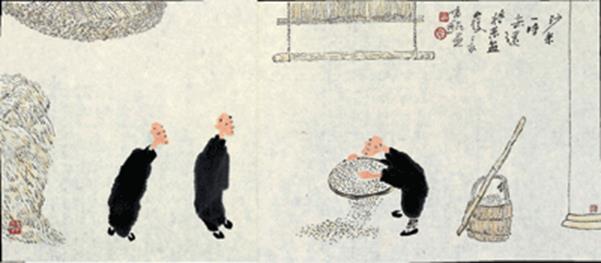
雪峰義存 Xuefeng Yicun (822-908) & 洞山良价 Dongshan Liangjie (807-869)

藥山惟儼 Yaoshan Weiyan (745-827 or 751-834) & 李翱 Li Ao (772–841)

馬祖道一 Mazu Daoyi (709-788) & 南泉普願 Nanquan Puyuan (748-835)
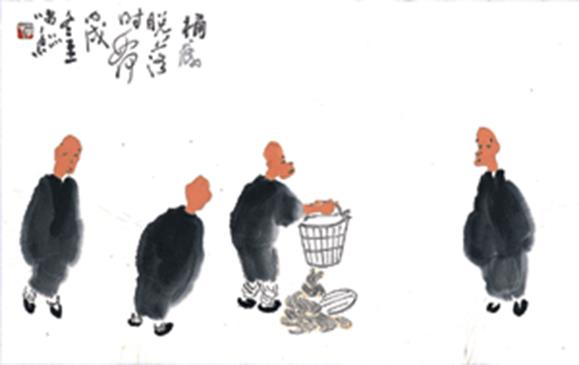
真歇清了 Zhenxie Qingliao (1089-1151), aka 長蘆清了 Changlu Qingliao

古靈神贊 Guling Shenzan (n.d.)

南北朝時有位僧侶問覺明禪師(三光禪師):「什麼叫做祖師西來意?」
覺明回答:「照顧腳下。」
– Miért jött ide nyugatról Bódhidharma? – kérdezte egy szerzetes.
– Nézz a lábad alá! – felelte a mester.

石霜慶諸 Shishuang Qingzhu (807-888)

Ha áll, fekszik, ül, jár az ember – mind a négy testhelyzetben lehet gyakorolni.